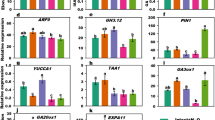Abstract
The application of CCC at concentrations inhibiting flowering ofChenopodium rubrum reduces the level of endogenous gibberellins in the apical buds of the plants. The effect of CCC may be reversed by appropriate concentrations of gibberellin (GA-), indole acetic acid (IAA) or kinetin. Kinetin applied to the apical bud during floral induction reduced the level of endogenous gibberellins similarly as CCC and if both CCC and kinetin were applied simultaneously their action was additive. On the other hand IAA applied under the same conditions increased the level of endogenous gibberellins and after joint application of CCC and IAA their level was the same as in untreated control plants. After application of CCC during floral induction the level of endogenous auxins did not change markedly but an active substance “x” appeared on the chromatograms of indole compounds. This substance was found also after simultaneous application of GA- and CCC but not after joint application of CCC and kinetin. If follows from our results that the same morphological phenomenon (flowering) can take place in plants considerably differing as to their level of endogenous growth substances. The ratio of different growth substances is obviously more important than the actual level of the single substances.
Abstract
CCC inhibující kveteníChenopodium rubrum snižuje v jeho apikálních pupenech hladinu endogenních giberelinů (GA). Reverse této inhibice se dá uskutečnit aplikací GA-, IAA nebo kinetinu. Kinetin aplikovaný na apikální pupeny rostlin během květní indukce snižuje hladinu endogenních GA stejně jako CCC a při současné aplikaci CCC a kinetinu působí obě tyto látky aditivně. Naproti tomu IAA aplikovaný za stejných podmínek hladinu endogenních GA zvyšuje a po současné aplikaci CCC a IAA je jejich hladina stejná jako u kontrolních rostlin. Po působení CCC v průběhu indukce se hladina endogenních auxinů nemění, ale na chiomatogramech se objevuje látka X”. Objevuje se rovněž při současné aplikaci GA a IAA ale nebyla nalezena po současné aplikaci CCC a kinetinu. Z výsledků vyplývá že k stejnému morfologickému jevu (kvetení) může dojít u rostlin u nichž hladina jednotlivých endogenních růstových látek je rozdílná. Zřejmě nezáleží tolik na koncentraci jednotlivých endogenních růstových látek nýbrž spíše na jejich vzájemném poměru.
Abstract
CCC ингибирующий цветениеChenopodium rubrum L. снижает в его апикальных почках уровень эндогенных гибберелинов. Ингибиция обратима применением ГК, ИУК или кинетина. Кинетин примененный на апикальные почки растений во время ивдукции цветения снижает уровень эндогенных губберелинов также как и CCC и при одновременной подаче CCC и кинетина действуют аддитивно. ИУК примененная при тех же условиях, напротив, повышает уровень эндогенных губберелинов. При одновременной подаче CCC и ИУК уровень эндогенных гибберелинов равен контролю. После воздействия CCC во время индукции уровень эндогенных ауксинов не меняется, но на хроматограммах появляется вещество ≪X≫. Это вещество появляется также при применении ГК и ИУК одновременно, но не было найдено при одновременном применении CCC и кинетина. Из результатов можно заключить, что морфологическое изменение (цветение) происходит у растений, у которых уровень отделных эндогенных ростовых веществ обеих веществ различна. Очевидно, более важно взаимное отношение вещества, чем концентрация ка ждой из них отдельно.
Similar content being viewed by others
References
Frankland, B., Wareing, P. F.: Effect of gibberellic acid on hypocotyl growth of lettuce seedlings.—Nature185: 255–256, 1961.
Klämbt, H. D.: Untersuchungen über Entwicklung und Wuchsstoffhaushalt beiRibes-Arten. I. Cytologische und wuchsstoffphysiologische Untersuchungen der Samen je einer Kultursorte vonRibes nigrum L. undRibes petraeum Wulf. ×Ribes multiflorum Kit. nach Selbst-und Fremdbestäubung.—Planta50: 526–556, 1958.
Larsen, P., Rajagopal, R.: The activity of indole-3-acetic acid in various auxin tests. In: Régulateurs naturels de la croissance végétale, (Gifs./Yvette), pp. 221–234, Edition du C.N.R.S., Paris, 1964.
Michniewicz, M., Kamieňska, A.: Effect of kinetin on the content of endogenous gibberellins in germinating seeds of some plant species.—Naturwiss.54: 372, 1967.
Nitsch, J. P.: The regulation of plant growth and flowering through chemical substances.—Proc. 15th internat. hort. Congr. (Nice), vol.1, pp. 55–65, 1958.
Nitsch, J. P., Nitsch, C.: Studies on the growth of coleoptile and first internode sections. A new sensitive, straight-growth test for auxins.—Plant Physiol.31: 94–111, 1956.
Phillips, I. D. J., Vlitos, A. J., Cutler, M.: The influence of gibberellic acid upon the endogenous growth substances of the Alaska pea.—Contr. Boyce Thompson Inst.20: 111–120, 1959.
Pilet, P. E.: Les phytohormones de croissance.—Masson et Cie, Paris, 1961.
Teltscherová, L., Havlíčková, H., Krekule, J.: Effect of (2-chloroethyl) trimethylammonium chloride (CCC) on the flowering ofChenopodium rubrum L.—Biol. Plant.9: 317–320, 1967.
Teltscherová, L., Havlíčková, H.: Reversal of the inhibitory effect of (2-chloroethyl)trimethylammonium chloride on the flowering ofChenopodium rubrum L. by kinetin.—Experientia23: 861, 1967.
Teltscherová, L.: Influence of gibberellin, auxin, kinetin and CCC on floral development ofChenopodium rubrum L.—Colloque international sur les aspects cellulaires et moleculaires de l'induction florale Liěge 1967 in press.
Wardlaw C. W.: Phylogeny and Morphogenesis.—MacMillan, London, 1952.
Author information
Authors and Affiliations
Additional information
Address: Ke dvoru 15, Praha-Vokovice, Czechoslovakia.
Rights and permissions
About this article
Cite this article
Teltscherová, L. Changes in the level of endogenous gibberellins and auxins in apical buds ofChenopodium rubrum L. after application of growth substances reversing the effect of (2-chlorethyl)-trimethylammonium chloride (CCC) on flowering. Biol Plant 10, 305–310 (1968). https://doi.org/10.1007/BF02921013
Received:
Issue Date:
DOI: https://doi.org/10.1007/BF02921013



